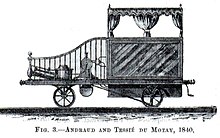Pneumatic railcar

Compressed air railcars were railcars that were operated with compressed air in the same way as compressed air locomotives . The compressed air was carried in pressure tanks on the vehicle and used with a piston engine to drive the vehicle. They were mostly used on trams .
history
The inventor Antoine Andraud and the chemist Cyprien Marie Tessié du Motay from Paris built the first pneumatic railcar in 1839, which carried out test drives on the route from Paris to Versailles in July 1840 . In a test drive with eight people, however, it only made it 1000 m before the compressed air supply was used up.
The technology was perfected by the Polish-born Louis Mékarski in France , who built a larger tram system with compressed air rail cars in Nantes . Other cities followed that used compressed air railcars.
Compared to steam trams, they had the advantage of being smoke-free, were able to negotiate steep inclines compared to horse-drawn trams and did not require overhead lines like an electric tram. From the turn of the century, the pneumatic railcars were nevertheless replaced by the electric railcars because they were more powerful than the pneumatic railcars.
technology
The compressed air for the operation of the piston machine was carried on the vehicle, whereby the tanks were mostly housed under the vehicle floor. Typically, there were tanks for 2000 to 3000 liters of compressed air, which were designed for pressures up to 80 atm . Before the compressed air was processed in the piston machine, its pressure had to be reduced by a pressure reducer from the container pressure to the working pressure of the piston machine, which was typically 6 to 7 atm.
A problem with using compressed air for the drive was preventing ice from forming in the cylinders of the reciprocating engine. For this purpose, the evaporation cold had to be suitably compensated in the pressure reducer when the compressed air was released. Andraud and Tessié du Motay's railcar already had a device called a heat box for heating the air at the pressure reducer. Mékarski used hot water to heat the air. The two engineers Popp and Conti experimented with a coke oven on the railcar, but it was unsuccessful.
The piston engine was arranged similarly to the engine of a steam locomotive . The first compressed air railcars had only one driven axle. Later, an arrangement with coupling rods , in which both axles were driven, prevailed. The piston machine worked with constant pressure. The performance was controlled by changing the filling.
Web links
Individual evidence
- ↑ AL Crelle: Mémoire sur les différentes manières de se servir de l'élasticité de l'air atmosphere comme force motrice sur les chemins de fer . In: Journal for pure and applied mathematics . Duncker and Humblot, 1846, p. 20 ( google.com [accessed January 8, 2020]).
- ↑ Antoine Andraud, Cyprien Marie Tessie du Motay: De l'air comprimé et dilate comme moteur ou des forces naturelles, recueillies gratuitement et mises en réserve . 2nd Edition. Guillaumin, Paris 1840 ( bnf.fr [accessed January 8, 2020]).
- ↑ About various railway systems . In: Allgemeine Bauzeitung Wien . 1846, 2nd application of compressed air as a moving force. System Andraud, S. 16-18 ( google.cz [accessed January 8, 2020]).
- ↑ a b HEFTI: Steam trams . Springer-Verlag, 2013, ISBN 978-3-0348-6512-8 , compressed air locomotives and compressed air railcars, p. 68 ff . ( google.com [accessed January 8, 2020]).
- ↑ About various railway systems . In: Allgemeine Bauzeitung Wien . 1846, 2nd application of compressed air as a moving force. System Andraud, S. 16-18 ( google.cz [accessed January 8, 2020]).
- ↑ Freiherr von Röll: Enzyklopädie des Eisenbahnwesens, Volume 3. Berlin, Vienna 1912, pp. 442–444.

